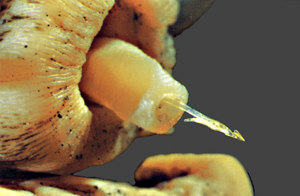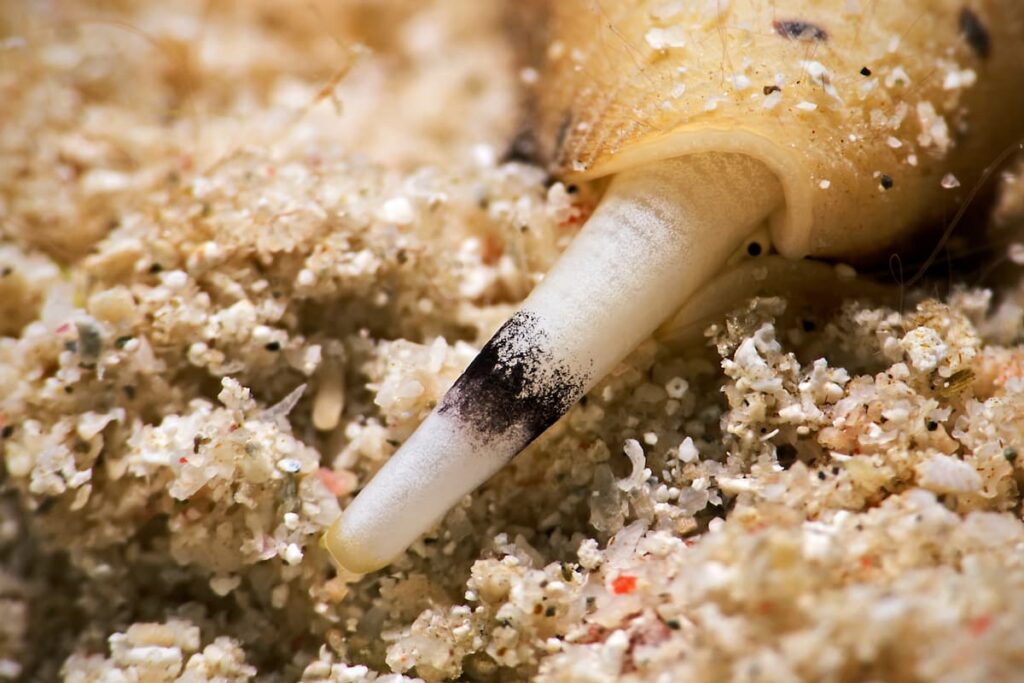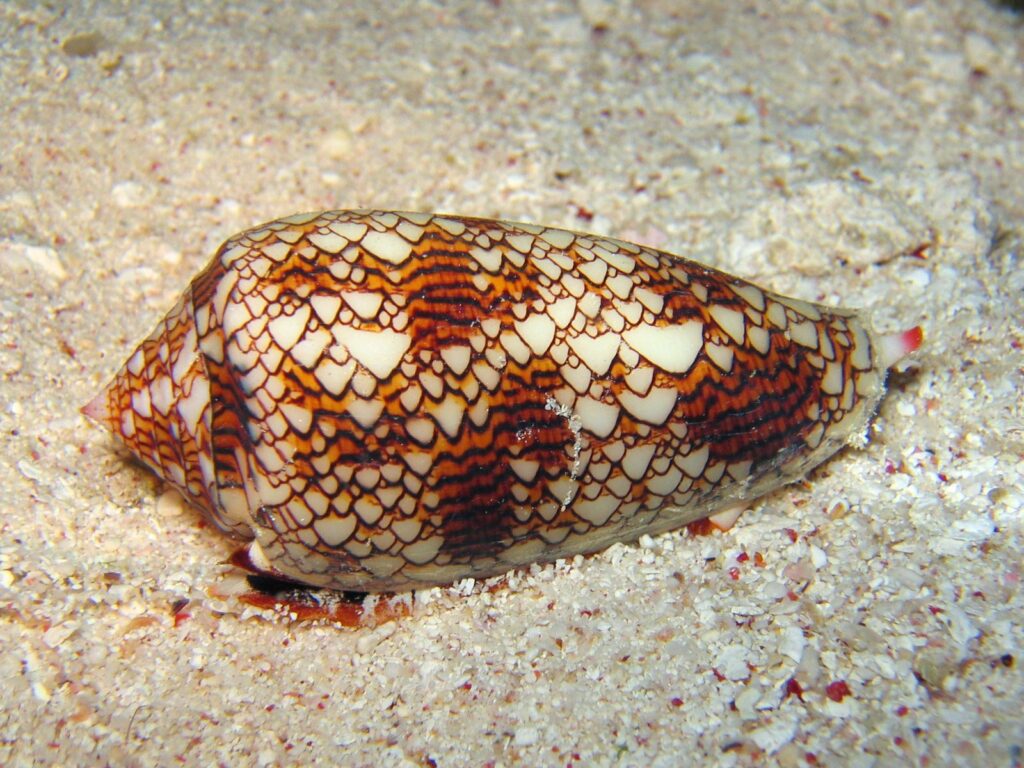Hunting Techniques
Cones snails, unlike most snails, actively hunt small fish, marine worms, and other mollusks with a harpoon-like dart and a powerful venom. Some species have enough venom to kill a person; there have been at least 36 documented cases of human fatalities.
Cone snails employ a combination of patience, stealth, and accuracy to capture their prey. First, they bury themselves in the sand or hide behind rocks, patiently waiting for their target to come near. Next, they extend their elongated, flexible proboscis towards their prey, ready to attack.
Harpoon-like Radula: Form and Function
The secret to the cone snail’s hunting prowess lies in its harpoon-like radula – a special structure made of chitin that functions as a combination of a spear and a hypodermic needle. As the proboscis reaches the prey, the radula is rapidly fired, like an underwater harpoon. Once the radula is embedded into the prey, it injects venom, immobilizing the victim almost instantly. The cone snail then reels in its captured meal to enjoy at leisure.
The harpoon-like structure that cone snails use for killing fish with deadly venom is called a radular tooth. Cone snails have a modified radula, which is a ribbon-like structure covered in thousands of small, sharp teeth, or denticles. One of the denticles in each row of teeth is modified into a long, hollow, barbed harpoon-like structure, which is used to inject venom into their prey.
When a cone snail detects a potential prey, it extends its proboscis and shoots out the radular tooth, which is attached to a muscular bulb called the venom bulb. The tooth is propelled out of the snail’s proboscis using a powerful muscular contraction, and it can reach its target in a fraction of a second.
Once the tooth has penetrated the prey, the venom bulb pumps venom through the hollow tooth and into the prey, paralyzing it and allowing the cone snail to consume it.
It’s important to note that cone snail venom can be deadly to humans as well, so it’s important to avoid handling or disturbing these creatures in the wild.

Venom Potency and Delivery
Cone snail venom is a complex cocktail of toxins, including peptides, that target different components of their prey’s nervous system, making them extremely potent.
The venom not only immobilizes the prey, but it may also cause paralysis or even death in some cases.
Cone snails can create many types of venom to catch prey or defend against predators.
Their venom contains over 500 different components, and there are 500 different species, so there are potentially 250,000 different compounds. Because each component may be valuable to people, the potential for scientific discovery is enormous.
The cone snail’s venom gland is like a bag filled with chemicals, with a long venom duct or hose attached to a harpoon-like teeth. They build several forms of venom and spew it out the other end of the duct. They can create a venom for killing fish and they can also create a different venom to protect themselves from predators.
How Many Venomous Harpoons Does Each Cone Snail Have?
The number of venomous harpoons, or modified radular teeth, that each cone snail has can vary depending on the species and size of the snail. Some species of cone snails have more venomous harpoons than others, and larger snails may have more teeth than smaller ones.
In general, cone snails have between 50 and 100 venomous harpoons in their radula at any given time. However, they are constantly replacing their radular teeth throughout their life, so the number of venomous harpoons that a cone snail has can change over time.

Human Interactions and Precautions
Deadly Encounters
Cone snails are intriguing creatures, but humans must approach them with caution. These beautiful shellfish are capable of injecting venom that can lead to severe pain and, in extreme cases, death.
There have been reported cases of fatalities resulting from accidental contact with the cone snail’s venomous harpoons. For those engaging in diving and coastal activities, it is important to stay aware of their surroundings and avoid touching or handling these fascinating but dangerous creatures.
There are many species of cone snails, and while all of them are venomous, only a few are considered to be highly dangerous to humans. The top deadliest species of cone snail include:

- Geography cone (Conus geographus): This species is responsible for the most human fatalities of any cone snail. Its venom contains a potent mix of toxins that can cause paralysis, respiratory failure, and death.
- Textile cone (Conus textile): This species is also highly venomous and can cause paralysis and death in humans. Its venom contains a mix of toxins that can affect the nervous system and the heart.
- Cigarette cone (Conus magus): This species is known for its highly potent venom, which can cause paralysis and death in humans. Its venom contains a mix of toxins that can affect the nervous system and the heart.
- Tulip cone (Conus tulipa): This species is highly venomous and can cause paralysis and death in humans. Its venom contains a mix of toxins that can affect the nervous system and the heart.
According to a study published in the journal Toxicon, there have been at least 36 documented cases of human fatalities caused by cone snail envenomations between 1927 and 2016. However, the actual number of fatalities may be higher, as some cases may have gone unreported or misdiagnosed.
It’s worth noting that while cone snail envenomations can be deadly, they are relatively rare. Most cases of envenomation result in pain, swelling, and other symptoms, but do not lead to death.
While the cone snail appears to be slow and harmless, it can be extremely dangerous to people.
Source:
Puillandre, N., Duda, T.F., Meyer, C., Olivera, B.M., & Bouchet, P. (2015). One, four or 100 genera? A new classification of the cone snails. Journal of Molluscan Studies, 81(1), 1-23. doi: 10.1093/mollus/eyu055.
Research and Potential Medical Applications
Cone snails have great potential for scientific discovery.
The cone snail’s venom has caught the eye of researchers in the medical community due to its unique bioactive compounds. Scientists have discovered that these compounds can target specific molecular sites in the body, potentially leading to the development of new therapeutic drugs.
Ziconotide, a pain-relief drug derived from cone snail venom, is one such example. Although still in its infancy, research on the potential applications of cone snail venom offers hope for the development of effective remedies for chronic or hard-to-treat conditions.
By investigating the cone snail’s hunting and feeding mechanisms, scientists have gained valuable insights into how these creatures have evolved such potent venom.
Additional research into the nervous systems, signaling pathways, and molecular structures of cone snails will undoubtedly uncover more potential applications in medicine and biotechnology.
With continued study, the deadly weapons of these fascinating and complex predators may one day yield life-saving treatments for a variety of human disorders.
Anatomy of Cone Snails
Cone snails, also known as Conus species, encompass a fascinating array of marine snails that exhibit unique and specialized adaptations for hunting and killing fish. In this section, we will explore the anatomy of cone snails, focusing on their shell characteristics and internal organs and systems.
Shell Characteristics

The cone snail’s shell is perhaps its most recognizable feature. These shells come in a variety of shapes, sizes, and colors, making them highly sought after by collectors. Some key aspects of their shells include:
-
Size: Cone snail shells can range from as small as 10 millimeters to over 230 millimeters in length, with larger species found primarily in deeper waters.
-
Shape: The shell is shaped like a cone, as the name suggests, and it is often smooth and shiny.
-
Color and Patterns: A striking aspect of cone snail shells is their vivid and diverse coloration, consisting of intricate patterns and sometimes even metallic hues.
These beautiful shells provide cone snails with more than just aesthetic appeal; their sturdy structure allows them to swiftly burrow into sand and provide protection from predators.

Internal Organs and Systems
Inside their alluring shells, cone snails have a set of specialized organs and systems that work together for efficient hunting and survival.
-
Radula: The radula is a ribbon-like structure with rows of tiny, razor-sharp teeth that enable the snail to quickly grasp prey and pull it inside their mouth.
The venomous harpoons are special adaptations of the teeth along the radula. -
Venom Apparatus: Cone snails produce potent venom that contains a complex mixture of toxins known as conotoxins. The venom is stored in a specialized venom gland and is injected into prey using a hollow, barbed tooth that is launched like a harpoon.
-
Siphon: A long, flexible tube called the siphon helps detect chemicals in the water, allowing the cone snail to sense prey from a distance.
-
Nervous System: Cone snails possess a highly-developed nervous system that allows them to react quickly to their environment and efficiently target prey. This system includes a set of highly sensitive eyes and an extraordinary sense of smell.
These fascinating adaptations make cone snails efficient predators, allowing them to not only survive in their aquatic environments but also claim the title as some of the oceans’ most mesmerizing yet deadly creatures.
Frequently Asked Questions
How do cone snails catch fish?
Cone snails catch fish using their highly specialized venomous harpoon-like tooth. They stealthily approach their prey and swiftly shoot this tooth into the fish, delivering a potent venom that paralyzes it. Once the fish is incapacitated, the snail can easily consume it.
How do they hunt prey?
Cone snails are skilled hunters, relying on their keen senses and predatory instincts. They utilize various hunting strategies, like hiding and waiting for their prey to come within striking distance, or extending their siphon to detect and locate their prey before launching their venomous tooth.
What is their method of killing?
The method of killing used by cone snails is their venomous tooth known as a radula. This tooth is hollow and acts as a hypodermic needle, allowing the snail to inject its potent venom directly into the prey.
The venom contains numerous peptides called conotoxins that affect the nervous system of the prey, leading to paralysis and death.
How are fish paralyzed by the cone snail?
The fish is paralyzed by the cone snail’s venom, which targets specific ion channels in the victim’s nerves and muscles.
The conotoxins interfere with the normal function of these ion channels, disrupting electrical signals needed for movement and, ultimately, causing paralysis. As a result, the fish can’t swim away and becomes an easy meal for the snail.
What are cone snail venom effects?
Cone snail venom contains a complex mixture of conotoxins, which can cause a wide range of effects on the prey. In addition to paralysis, the venom may cause muscle contractions, difficulty breathing, and even heart problems.
In certain cases, the venom can also be lethal to humans, making cone snails one of the most venomous creatures on Earth.
Reference
Jiménez-Tenorio, Manuel. (2011). Cone radular anatomy as a proxy for phylogeny and for conotoxin diversity. 10.13140/RG.2.1.2725.9921.

